Quantum Computing in Medical & Healthcare Sector
VerifiedAdded on 2022/11/29
|11
|3575
|443
AI Summary
This research explores the applications of quantum computing in the medical and healthcare sector. It aims to understand the difference between classical and quantum computing capabilities and how quantum computing can bring innovation in the medical sector. The research methodology involves a mixed qualitative research approach, including literature review and interviews with quantum computing solution providers. The findings will provide insights into the potential applications of quantum computing in healthcare.
Contribute Materials
Your contribution can guide someone’s learning journey. Share your
documents today.
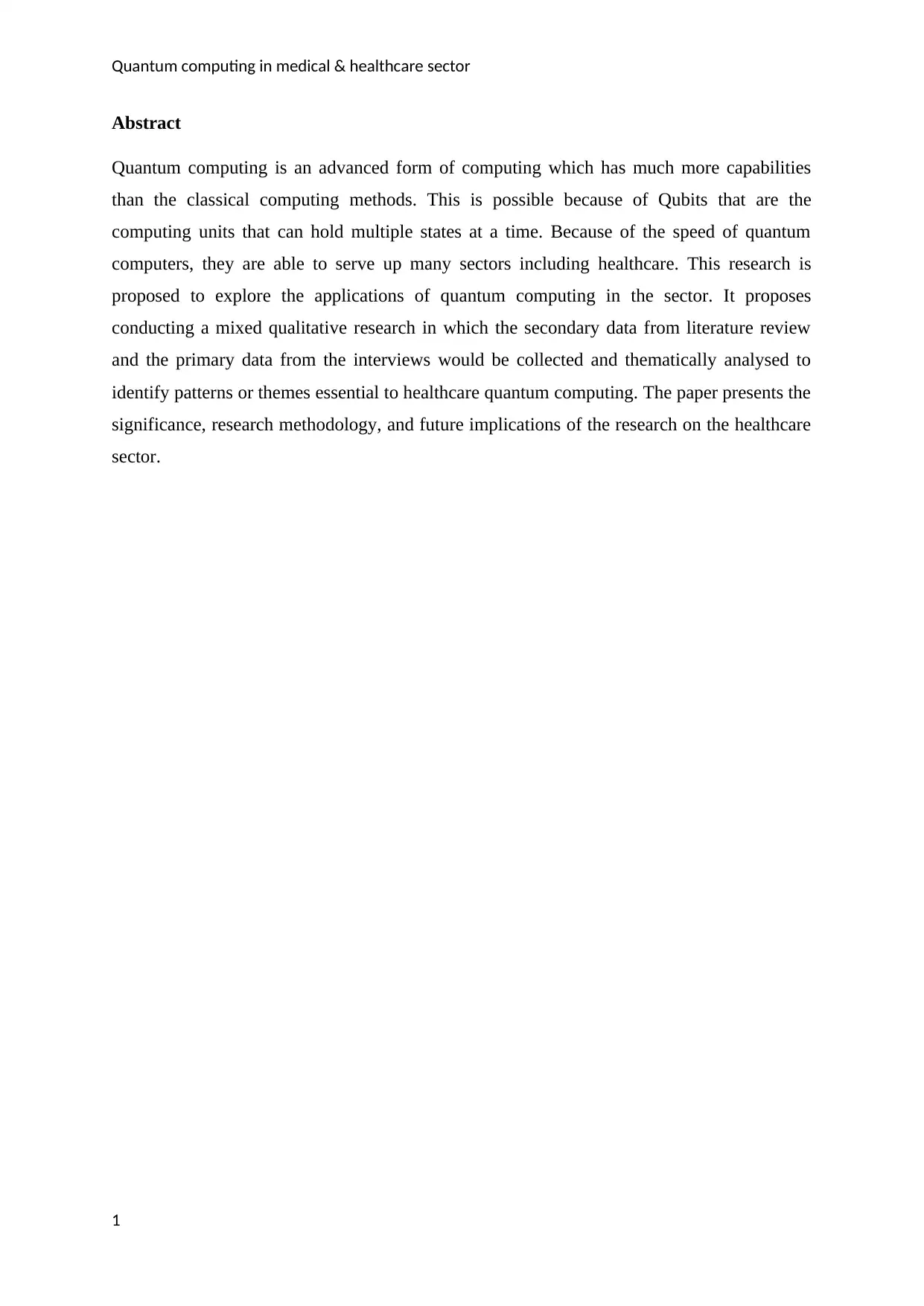
Quantum computing in medical & healthcare sector
Abstract
Quantum computing is an advanced form of computing which has much more capabilities
than the classical computing methods. This is possible because of Qubits that are the
computing units that can hold multiple states at a time. Because of the speed of quantum
computers, they are able to serve up many sectors including healthcare. This research is
proposed to explore the applications of quantum computing in the sector. It proposes
conducting a mixed qualitative research in which the secondary data from literature review
and the primary data from the interviews would be collected and thematically analysed to
identify patterns or themes essential to healthcare quantum computing. The paper presents the
significance, research methodology, and future implications of the research on the healthcare
sector.
1
Abstract
Quantum computing is an advanced form of computing which has much more capabilities
than the classical computing methods. This is possible because of Qubits that are the
computing units that can hold multiple states at a time. Because of the speed of quantum
computers, they are able to serve up many sectors including healthcare. This research is
proposed to explore the applications of quantum computing in the sector. It proposes
conducting a mixed qualitative research in which the secondary data from literature review
and the primary data from the interviews would be collected and thematically analysed to
identify patterns or themes essential to healthcare quantum computing. The paper presents the
significance, research methodology, and future implications of the research on the healthcare
sector.
1
Secure Best Marks with AI Grader
Need help grading? Try our AI Grader for instant feedback on your assignments.
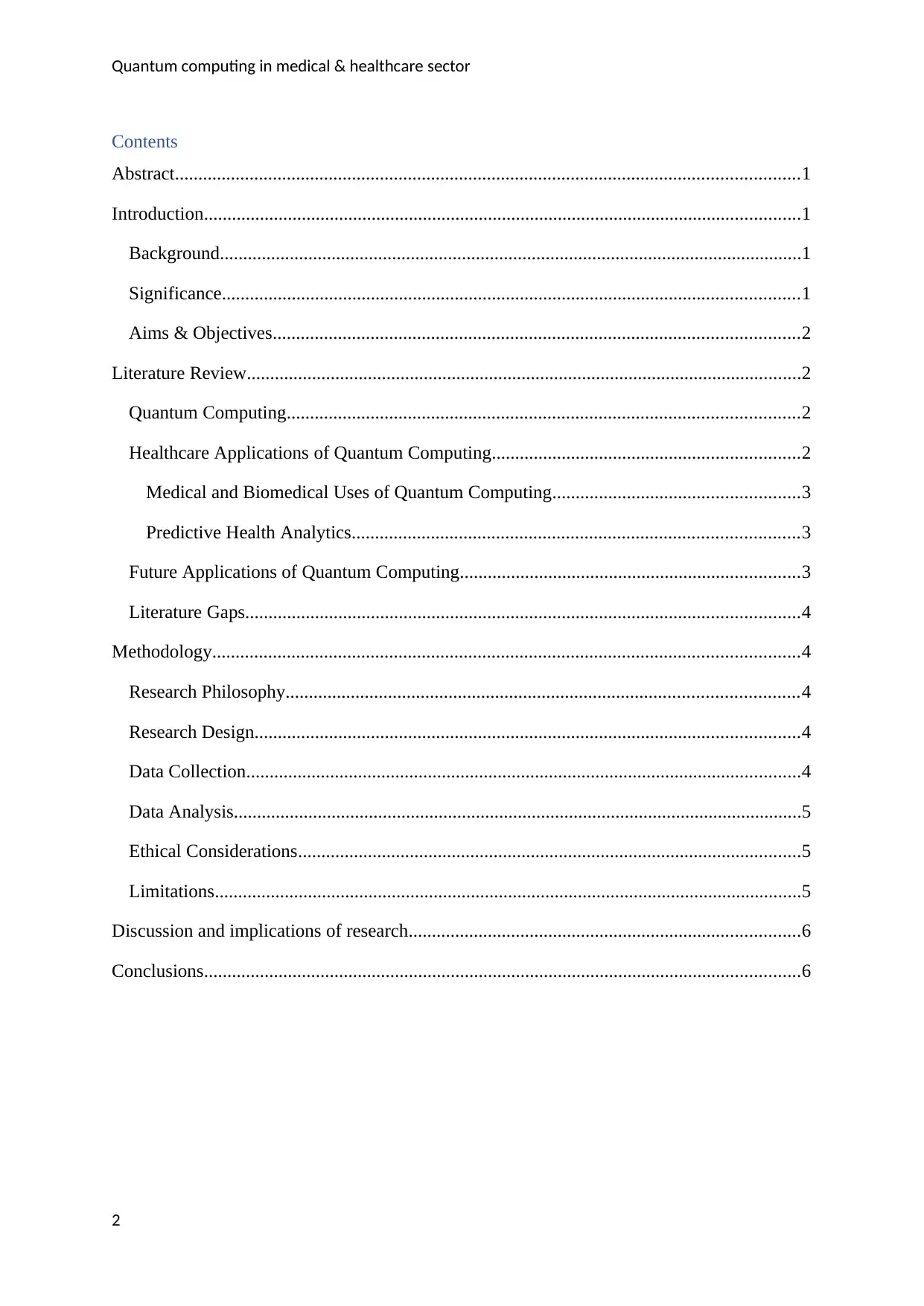
Quantum computing in medical & healthcare sector
Contents
Abstract......................................................................................................................................1
Introduction................................................................................................................................1
Background.............................................................................................................................1
Significance............................................................................................................................1
Aims & Objectives.................................................................................................................2
Literature Review.......................................................................................................................2
Quantum Computing..............................................................................................................2
Healthcare Applications of Quantum Computing..................................................................2
Medical and Biomedical Uses of Quantum Computing.....................................................3
Predictive Health Analytics................................................................................................3
Future Applications of Quantum Computing.........................................................................3
Literature Gaps.......................................................................................................................4
Methodology..............................................................................................................................4
Research Philosophy..............................................................................................................4
Research Design.....................................................................................................................4
Data Collection.......................................................................................................................4
Data Analysis..........................................................................................................................5
Ethical Considerations............................................................................................................5
Limitations..............................................................................................................................5
Discussion and implications of research....................................................................................6
Conclusions................................................................................................................................6
2
Contents
Abstract......................................................................................................................................1
Introduction................................................................................................................................1
Background.............................................................................................................................1
Significance............................................................................................................................1
Aims & Objectives.................................................................................................................2
Literature Review.......................................................................................................................2
Quantum Computing..............................................................................................................2
Healthcare Applications of Quantum Computing..................................................................2
Medical and Biomedical Uses of Quantum Computing.....................................................3
Predictive Health Analytics................................................................................................3
Future Applications of Quantum Computing.........................................................................3
Literature Gaps.......................................................................................................................4
Methodology..............................................................................................................................4
Research Philosophy..............................................................................................................4
Research Design.....................................................................................................................4
Data Collection.......................................................................................................................4
Data Analysis..........................................................................................................................5
Ethical Considerations............................................................................................................5
Limitations..............................................................................................................................5
Discussion and implications of research....................................................................................6
Conclusions................................................................................................................................6
2
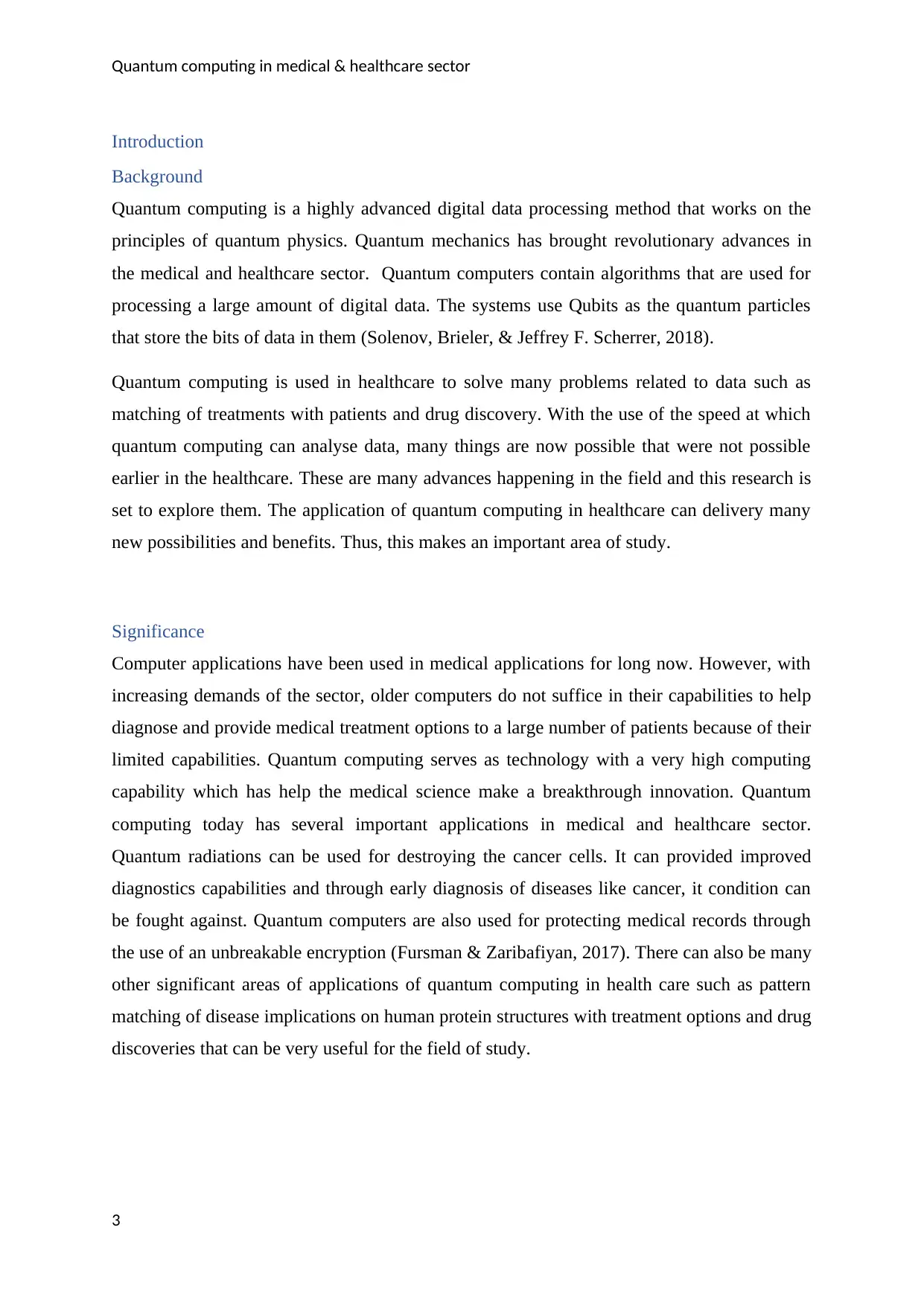
Quantum computing in medical & healthcare sector
Introduction
Background
Quantum computing is a highly advanced digital data processing method that works on the
principles of quantum physics. Quantum mechanics has brought revolutionary advances in
the medical and healthcare sector. Quantum computers contain algorithms that are used for
processing a large amount of digital data. The systems use Qubits as the quantum particles
that store the bits of data in them (Solenov, Brieler, & Jeffrey F. Scherrer, 2018).
Quantum computing is used in healthcare to solve many problems related to data such as
matching of treatments with patients and drug discovery. With the use of the speed at which
quantum computing can analyse data, many things are now possible that were not possible
earlier in the healthcare. These are many advances happening in the field and this research is
set to explore them. The application of quantum computing in healthcare can delivery many
new possibilities and benefits. Thus, this makes an important area of study.
Significance
Computer applications have been used in medical applications for long now. However, with
increasing demands of the sector, older computers do not suffice in their capabilities to help
diagnose and provide medical treatment options to a large number of patients because of their
limited capabilities. Quantum computing serves as technology with a very high computing
capability which has help the medical science make a breakthrough innovation. Quantum
computing today has several important applications in medical and healthcare sector.
Quantum radiations can be used for destroying the cancer cells. It can provided improved
diagnostics capabilities and through early diagnosis of diseases like cancer, it condition can
be fought against. Quantum computers are also used for protecting medical records through
the use of an unbreakable encryption (Fursman & Zaribafiyan, 2017). There can also be many
other significant areas of applications of quantum computing in health care such as pattern
matching of disease implications on human protein structures with treatment options and drug
discoveries that can be very useful for the field of study.
3
Introduction
Background
Quantum computing is a highly advanced digital data processing method that works on the
principles of quantum physics. Quantum mechanics has brought revolutionary advances in
the medical and healthcare sector. Quantum computers contain algorithms that are used for
processing a large amount of digital data. The systems use Qubits as the quantum particles
that store the bits of data in them (Solenov, Brieler, & Jeffrey F. Scherrer, 2018).
Quantum computing is used in healthcare to solve many problems related to data such as
matching of treatments with patients and drug discovery. With the use of the speed at which
quantum computing can analyse data, many things are now possible that were not possible
earlier in the healthcare. These are many advances happening in the field and this research is
set to explore them. The application of quantum computing in healthcare can delivery many
new possibilities and benefits. Thus, this makes an important area of study.
Significance
Computer applications have been used in medical applications for long now. However, with
increasing demands of the sector, older computers do not suffice in their capabilities to help
diagnose and provide medical treatment options to a large number of patients because of their
limited capabilities. Quantum computing serves as technology with a very high computing
capability which has help the medical science make a breakthrough innovation. Quantum
computing today has several important applications in medical and healthcare sector.
Quantum radiations can be used for destroying the cancer cells. It can provided improved
diagnostics capabilities and through early diagnosis of diseases like cancer, it condition can
be fought against. Quantum computers are also used for protecting medical records through
the use of an unbreakable encryption (Fursman & Zaribafiyan, 2017). There can also be many
other significant areas of applications of quantum computing in health care such as pattern
matching of disease implications on human protein structures with treatment options and drug
discoveries that can be very useful for the field of study.
3
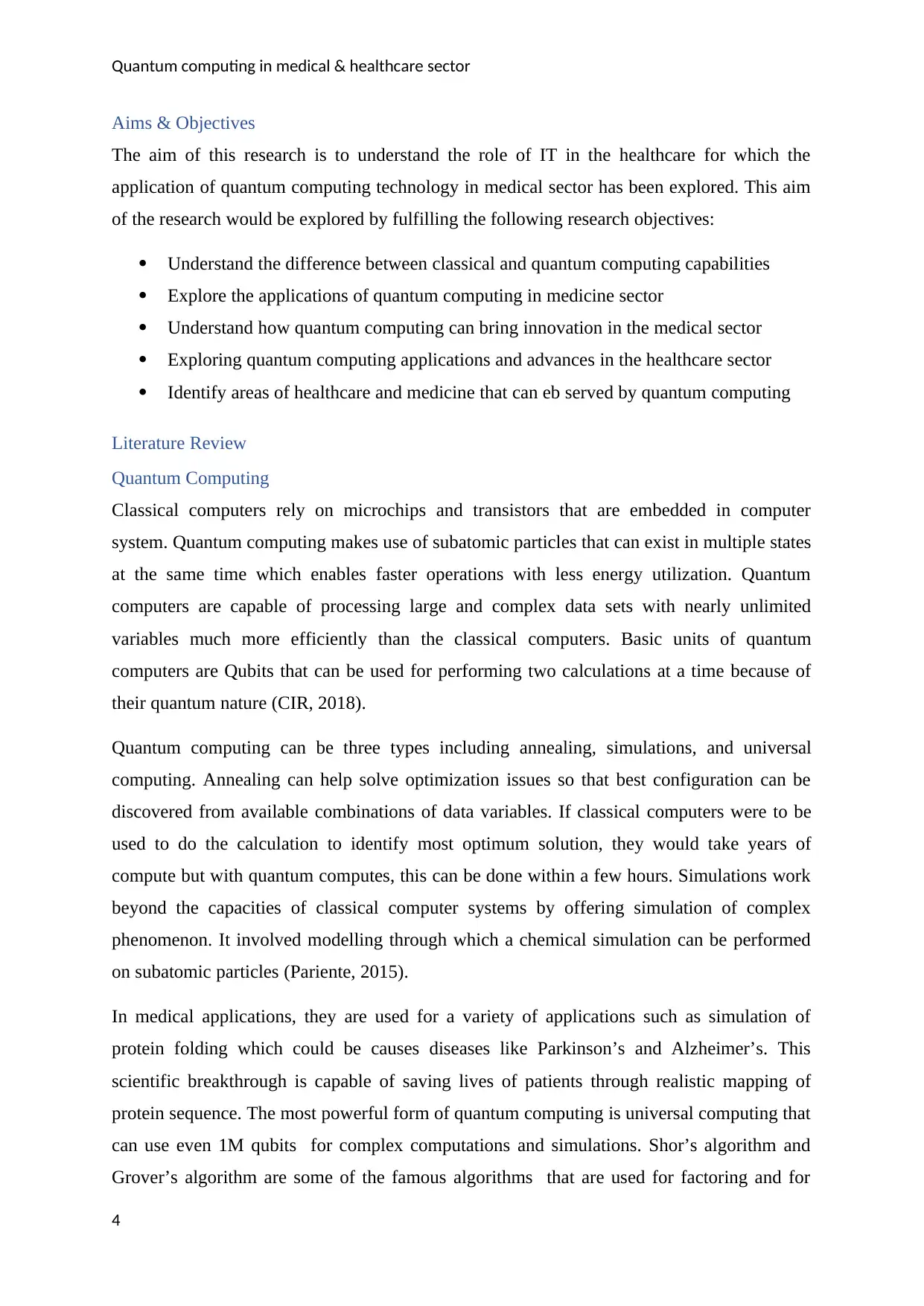
Quantum computing in medical & healthcare sector
Aims & Objectives
The aim of this research is to understand the role of IT in the healthcare for which the
application of quantum computing technology in medical sector has been explored. This aim
of the research would be explored by fulfilling the following research objectives:
Understand the difference between classical and quantum computing capabilities
Explore the applications of quantum computing in medicine sector
Understand how quantum computing can bring innovation in the medical sector
Exploring quantum computing applications and advances in the healthcare sector
Identify areas of healthcare and medicine that can eb served by quantum computing
Literature Review
Quantum Computing
Classical computers rely on microchips and transistors that are embedded in computer
system. Quantum computing makes use of subatomic particles that can exist in multiple states
at the same time which enables faster operations with less energy utilization. Quantum
computers are capable of processing large and complex data sets with nearly unlimited
variables much more efficiently than the classical computers. Basic units of quantum
computers are Qubits that can be used for performing two calculations at a time because of
their quantum nature (CIR, 2018).
Quantum computing can be three types including annealing, simulations, and universal
computing. Annealing can help solve optimization issues so that best configuration can be
discovered from available combinations of data variables. If classical computers were to be
used to do the calculation to identify most optimum solution, they would take years of
compute but with quantum computes, this can be done within a few hours. Simulations work
beyond the capacities of classical computer systems by offering simulation of complex
phenomenon. It involved modelling through which a chemical simulation can be performed
on subatomic particles (Pariente, 2015).
In medical applications, they are used for a variety of applications such as simulation of
protein folding which could be causes diseases like Parkinson’s and Alzheimer’s. This
scientific breakthrough is capable of saving lives of patients through realistic mapping of
protein sequence. The most powerful form of quantum computing is universal computing that
can use even 1M qubits for complex computations and simulations. Shor’s algorithm and
Grover’s algorithm are some of the famous algorithms that are used for factoring and for
4
Aims & Objectives
The aim of this research is to understand the role of IT in the healthcare for which the
application of quantum computing technology in medical sector has been explored. This aim
of the research would be explored by fulfilling the following research objectives:
Understand the difference between classical and quantum computing capabilities
Explore the applications of quantum computing in medicine sector
Understand how quantum computing can bring innovation in the medical sector
Exploring quantum computing applications and advances in the healthcare sector
Identify areas of healthcare and medicine that can eb served by quantum computing
Literature Review
Quantum Computing
Classical computers rely on microchips and transistors that are embedded in computer
system. Quantum computing makes use of subatomic particles that can exist in multiple states
at the same time which enables faster operations with less energy utilization. Quantum
computers are capable of processing large and complex data sets with nearly unlimited
variables much more efficiently than the classical computers. Basic units of quantum
computers are Qubits that can be used for performing two calculations at a time because of
their quantum nature (CIR, 2018).
Quantum computing can be three types including annealing, simulations, and universal
computing. Annealing can help solve optimization issues so that best configuration can be
discovered from available combinations of data variables. If classical computers were to be
used to do the calculation to identify most optimum solution, they would take years of
compute but with quantum computes, this can be done within a few hours. Simulations work
beyond the capacities of classical computer systems by offering simulation of complex
phenomenon. It involved modelling through which a chemical simulation can be performed
on subatomic particles (Pariente, 2015).
In medical applications, they are used for a variety of applications such as simulation of
protein folding which could be causes diseases like Parkinson’s and Alzheimer’s. This
scientific breakthrough is capable of saving lives of patients through realistic mapping of
protein sequence. The most powerful form of quantum computing is universal computing that
can use even 1M qubits for complex computations and simulations. Shor’s algorithm and
Grover’s algorithm are some of the famous algorithms that are used for factoring and for
4
Secure Best Marks with AI Grader
Need help grading? Try our AI Grader for instant feedback on your assignments.
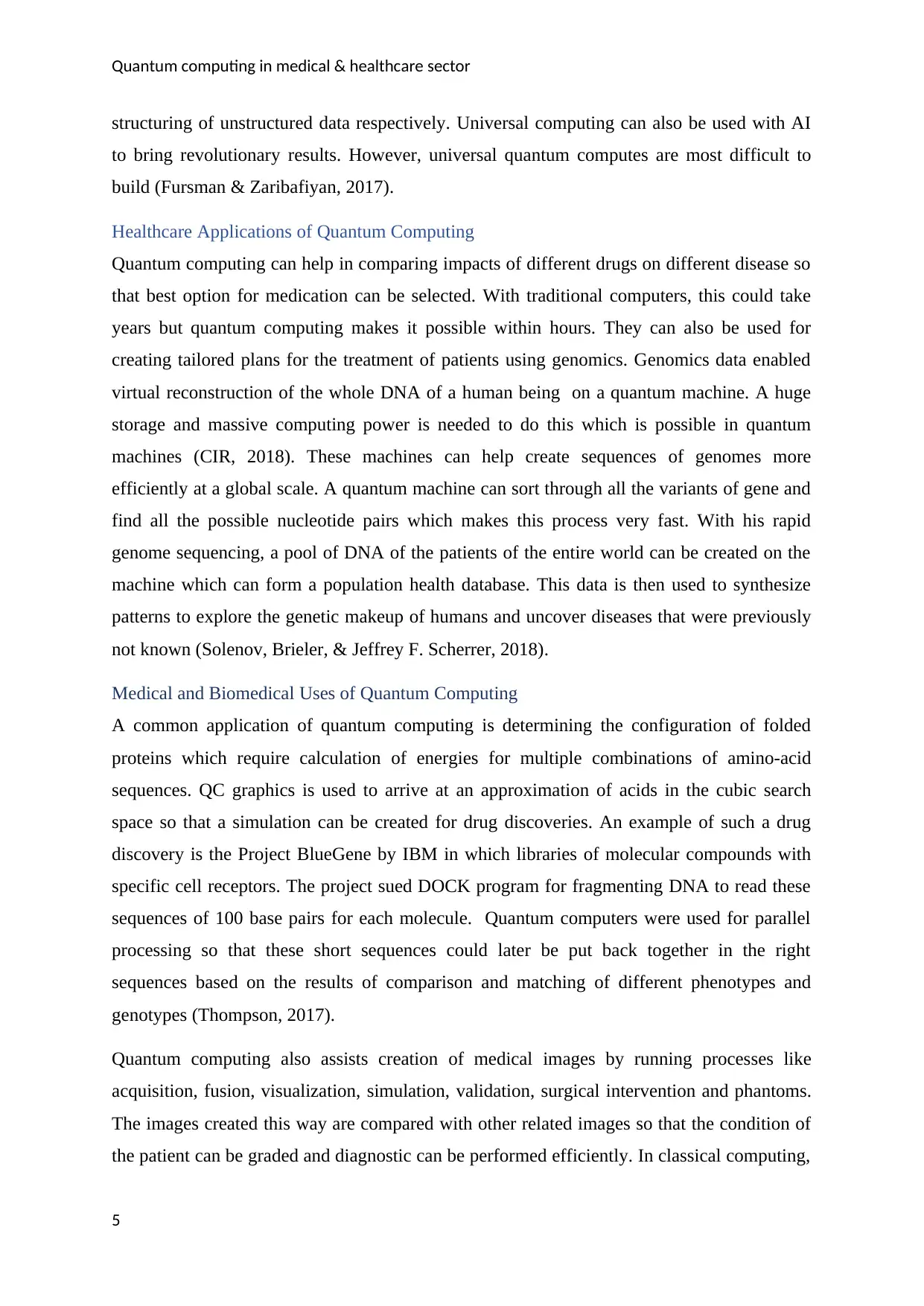
Quantum computing in medical & healthcare sector
structuring of unstructured data respectively. Universal computing can also be used with AI
to bring revolutionary results. However, universal quantum computes are most difficult to
build (Fursman & Zaribafiyan, 2017).
Healthcare Applications of Quantum Computing
Quantum computing can help in comparing impacts of different drugs on different disease so
that best option for medication can be selected. With traditional computers, this could take
years but quantum computing makes it possible within hours. They can also be used for
creating tailored plans for the treatment of patients using genomics. Genomics data enabled
virtual reconstruction of the whole DNA of a human being on a quantum machine. A huge
storage and massive computing power is needed to do this which is possible in quantum
machines (CIR, 2018). These machines can help create sequences of genomes more
efficiently at a global scale. A quantum machine can sort through all the variants of gene and
find all the possible nucleotide pairs which makes this process very fast. With his rapid
genome sequencing, a pool of DNA of the patients of the entire world can be created on the
machine which can form a population health database. This data is then used to synthesize
patterns to explore the genetic makeup of humans and uncover diseases that were previously
not known (Solenov, Brieler, & Jeffrey F. Scherrer, 2018).
Medical and Biomedical Uses of Quantum Computing
A common application of quantum computing is determining the configuration of folded
proteins which require calculation of energies for multiple combinations of amino-acid
sequences. QC graphics is used to arrive at an approximation of acids in the cubic search
space so that a simulation can be created for drug discoveries. An example of such a drug
discovery is the Project BlueGene by IBM in which libraries of molecular compounds with
specific cell receptors. The project sued DOCK program for fragmenting DNA to read these
sequences of 100 base pairs for each molecule. Quantum computers were used for parallel
processing so that these short sequences could later be put back together in the right
sequences based on the results of comparison and matching of different phenotypes and
genotypes (Thompson, 2017).
Quantum computing also assists creation of medical images by running processes like
acquisition, fusion, visualization, simulation, validation, surgical intervention and phantoms.
The images created this way are compared with other related images so that the condition of
the patient can be graded and diagnostic can be performed efficiently. In classical computing,
5
structuring of unstructured data respectively. Universal computing can also be used with AI
to bring revolutionary results. However, universal quantum computes are most difficult to
build (Fursman & Zaribafiyan, 2017).
Healthcare Applications of Quantum Computing
Quantum computing can help in comparing impacts of different drugs on different disease so
that best option for medication can be selected. With traditional computers, this could take
years but quantum computing makes it possible within hours. They can also be used for
creating tailored plans for the treatment of patients using genomics. Genomics data enabled
virtual reconstruction of the whole DNA of a human being on a quantum machine. A huge
storage and massive computing power is needed to do this which is possible in quantum
machines (CIR, 2018). These machines can help create sequences of genomes more
efficiently at a global scale. A quantum machine can sort through all the variants of gene and
find all the possible nucleotide pairs which makes this process very fast. With his rapid
genome sequencing, a pool of DNA of the patients of the entire world can be created on the
machine which can form a population health database. This data is then used to synthesize
patterns to explore the genetic makeup of humans and uncover diseases that were previously
not known (Solenov, Brieler, & Jeffrey F. Scherrer, 2018).
Medical and Biomedical Uses of Quantum Computing
A common application of quantum computing is determining the configuration of folded
proteins which require calculation of energies for multiple combinations of amino-acid
sequences. QC graphics is used to arrive at an approximation of acids in the cubic search
space so that a simulation can be created for drug discoveries. An example of such a drug
discovery is the Project BlueGene by IBM in which libraries of molecular compounds with
specific cell receptors. The project sued DOCK program for fragmenting DNA to read these
sequences of 100 base pairs for each molecule. Quantum computers were used for parallel
processing so that these short sequences could later be put back together in the right
sequences based on the results of comparison and matching of different phenotypes and
genotypes (Thompson, 2017).
Quantum computing also assists creation of medical images by running processes like
acquisition, fusion, visualization, simulation, validation, surgical intervention and phantoms.
The images created this way are compared with other related images so that the condition of
the patient can be graded and diagnostic can be performed efficiently. In classical computing,
5
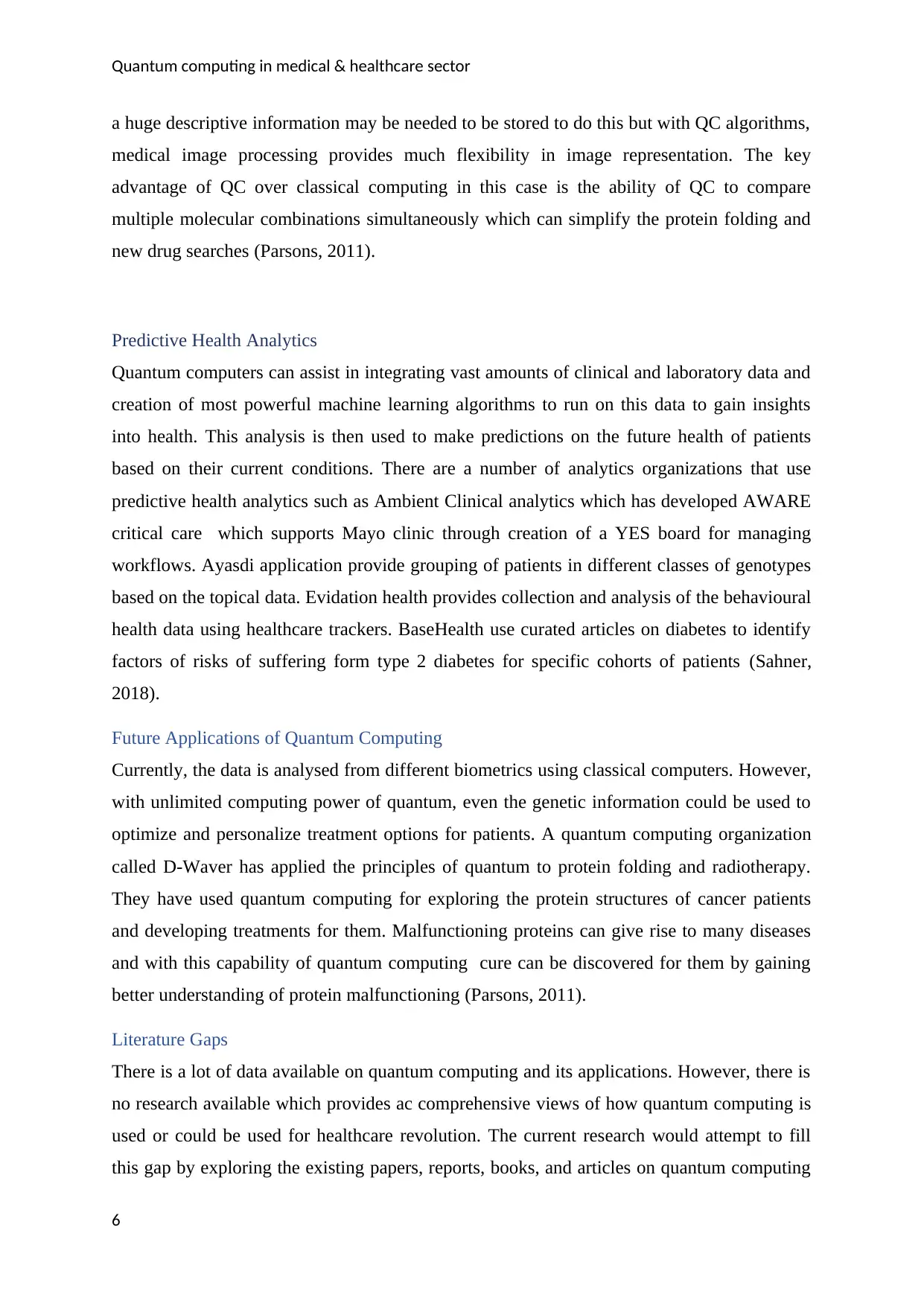
Quantum computing in medical & healthcare sector
a huge descriptive information may be needed to be stored to do this but with QC algorithms,
medical image processing provides much flexibility in image representation. The key
advantage of QC over classical computing in this case is the ability of QC to compare
multiple molecular combinations simultaneously which can simplify the protein folding and
new drug searches (Parsons, 2011).
Predictive Health Analytics
Quantum computers can assist in integrating vast amounts of clinical and laboratory data and
creation of most powerful machine learning algorithms to run on this data to gain insights
into health. This analysis is then used to make predictions on the future health of patients
based on their current conditions. There are a number of analytics organizations that use
predictive health analytics such as Ambient Clinical analytics which has developed AWARE
critical care which supports Mayo clinic through creation of a YES board for managing
workflows. Ayasdi application provide grouping of patients in different classes of genotypes
based on the topical data. Evidation health provides collection and analysis of the behavioural
health data using healthcare trackers. BaseHealth use curated articles on diabetes to identify
factors of risks of suffering form type 2 diabetes for specific cohorts of patients (Sahner,
2018).
Future Applications of Quantum Computing
Currently, the data is analysed from different biometrics using classical computers. However,
with unlimited computing power of quantum, even the genetic information could be used to
optimize and personalize treatment options for patients. A quantum computing organization
called D-Waver has applied the principles of quantum to protein folding and radiotherapy.
They have used quantum computing for exploring the protein structures of cancer patients
and developing treatments for them. Malfunctioning proteins can give rise to many diseases
and with this capability of quantum computing cure can be discovered for them by gaining
better understanding of protein malfunctioning (Parsons, 2011).
Literature Gaps
There is a lot of data available on quantum computing and its applications. However, there is
no research available which provides ac comprehensive views of how quantum computing is
used or could be used for healthcare revolution. The current research would attempt to fill
this gap by exploring the existing papers, reports, books, and articles on quantum computing
6
a huge descriptive information may be needed to be stored to do this but with QC algorithms,
medical image processing provides much flexibility in image representation. The key
advantage of QC over classical computing in this case is the ability of QC to compare
multiple molecular combinations simultaneously which can simplify the protein folding and
new drug searches (Parsons, 2011).
Predictive Health Analytics
Quantum computers can assist in integrating vast amounts of clinical and laboratory data and
creation of most powerful machine learning algorithms to run on this data to gain insights
into health. This analysis is then used to make predictions on the future health of patients
based on their current conditions. There are a number of analytics organizations that use
predictive health analytics such as Ambient Clinical analytics which has developed AWARE
critical care which supports Mayo clinic through creation of a YES board for managing
workflows. Ayasdi application provide grouping of patients in different classes of genotypes
based on the topical data. Evidation health provides collection and analysis of the behavioural
health data using healthcare trackers. BaseHealth use curated articles on diabetes to identify
factors of risks of suffering form type 2 diabetes for specific cohorts of patients (Sahner,
2018).
Future Applications of Quantum Computing
Currently, the data is analysed from different biometrics using classical computers. However,
with unlimited computing power of quantum, even the genetic information could be used to
optimize and personalize treatment options for patients. A quantum computing organization
called D-Waver has applied the principles of quantum to protein folding and radiotherapy.
They have used quantum computing for exploring the protein structures of cancer patients
and developing treatments for them. Malfunctioning proteins can give rise to many diseases
and with this capability of quantum computing cure can be discovered for them by gaining
better understanding of protein malfunctioning (Parsons, 2011).
Literature Gaps
There is a lot of data available on quantum computing and its applications. However, there is
no research available which provides ac comprehensive views of how quantum computing is
used or could be used for healthcare revolution. The current research would attempt to fill
this gap by exploring the existing papers, reports, books, and articles on quantum computing
6
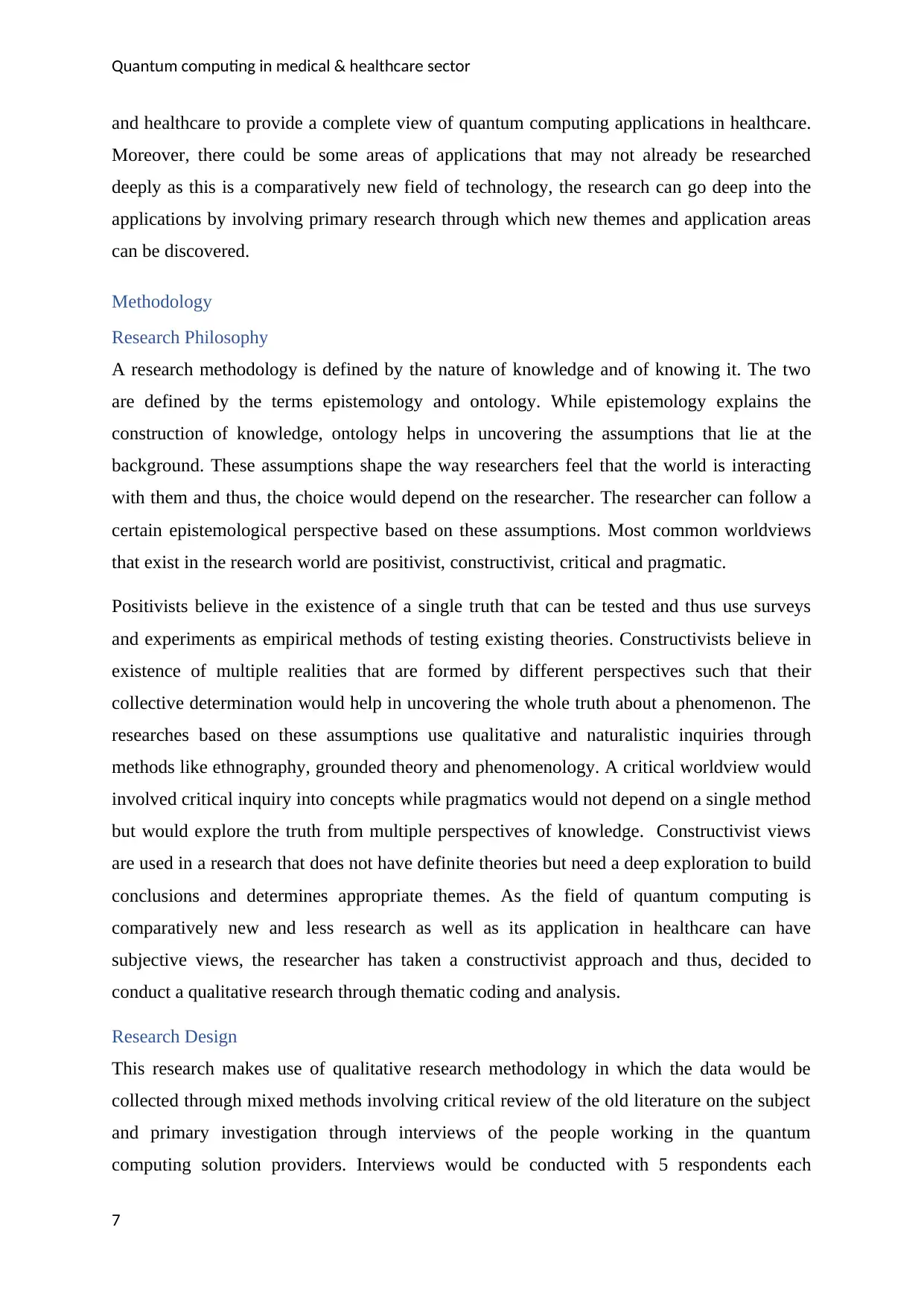
Quantum computing in medical & healthcare sector
and healthcare to provide a complete view of quantum computing applications in healthcare.
Moreover, there could be some areas of applications that may not already be researched
deeply as this is a comparatively new field of technology, the research can go deep into the
applications by involving primary research through which new themes and application areas
can be discovered.
Methodology
Research Philosophy
A research methodology is defined by the nature of knowledge and of knowing it. The two
are defined by the terms epistemology and ontology. While epistemology explains the
construction of knowledge, ontology helps in uncovering the assumptions that lie at the
background. These assumptions shape the way researchers feel that the world is interacting
with them and thus, the choice would depend on the researcher. The researcher can follow a
certain epistemological perspective based on these assumptions. Most common worldviews
that exist in the research world are positivist, constructivist, critical and pragmatic.
Positivists believe in the existence of a single truth that can be tested and thus use surveys
and experiments as empirical methods of testing existing theories. Constructivists believe in
existence of multiple realities that are formed by different perspectives such that their
collective determination would help in uncovering the whole truth about a phenomenon. The
researches based on these assumptions use qualitative and naturalistic inquiries through
methods like ethnography, grounded theory and phenomenology. A critical worldview would
involved critical inquiry into concepts while pragmatics would not depend on a single method
but would explore the truth from multiple perspectives of knowledge. Constructivist views
are used in a research that does not have definite theories but need a deep exploration to build
conclusions and determines appropriate themes. As the field of quantum computing is
comparatively new and less research as well as its application in healthcare can have
subjective views, the researcher has taken a constructivist approach and thus, decided to
conduct a qualitative research through thematic coding and analysis.
Research Design
This research makes use of qualitative research methodology in which the data would be
collected through mixed methods involving critical review of the old literature on the subject
and primary investigation through interviews of the people working in the quantum
computing solution providers. Interviews would be conducted with 5 respondents each
7
and healthcare to provide a complete view of quantum computing applications in healthcare.
Moreover, there could be some areas of applications that may not already be researched
deeply as this is a comparatively new field of technology, the research can go deep into the
applications by involving primary research through which new themes and application areas
can be discovered.
Methodology
Research Philosophy
A research methodology is defined by the nature of knowledge and of knowing it. The two
are defined by the terms epistemology and ontology. While epistemology explains the
construction of knowledge, ontology helps in uncovering the assumptions that lie at the
background. These assumptions shape the way researchers feel that the world is interacting
with them and thus, the choice would depend on the researcher. The researcher can follow a
certain epistemological perspective based on these assumptions. Most common worldviews
that exist in the research world are positivist, constructivist, critical and pragmatic.
Positivists believe in the existence of a single truth that can be tested and thus use surveys
and experiments as empirical methods of testing existing theories. Constructivists believe in
existence of multiple realities that are formed by different perspectives such that their
collective determination would help in uncovering the whole truth about a phenomenon. The
researches based on these assumptions use qualitative and naturalistic inquiries through
methods like ethnography, grounded theory and phenomenology. A critical worldview would
involved critical inquiry into concepts while pragmatics would not depend on a single method
but would explore the truth from multiple perspectives of knowledge. Constructivist views
are used in a research that does not have definite theories but need a deep exploration to build
conclusions and determines appropriate themes. As the field of quantum computing is
comparatively new and less research as well as its application in healthcare can have
subjective views, the researcher has taken a constructivist approach and thus, decided to
conduct a qualitative research through thematic coding and analysis.
Research Design
This research makes use of qualitative research methodology in which the data would be
collected through mixed methods involving critical review of the old literature on the subject
and primary investigation through interviews of the people working in the quantum
computing solution providers. Interviews would be conducted with 5 respondents each
7
Paraphrase This Document
Need a fresh take? Get an instant paraphrase of this document with our AI Paraphraser
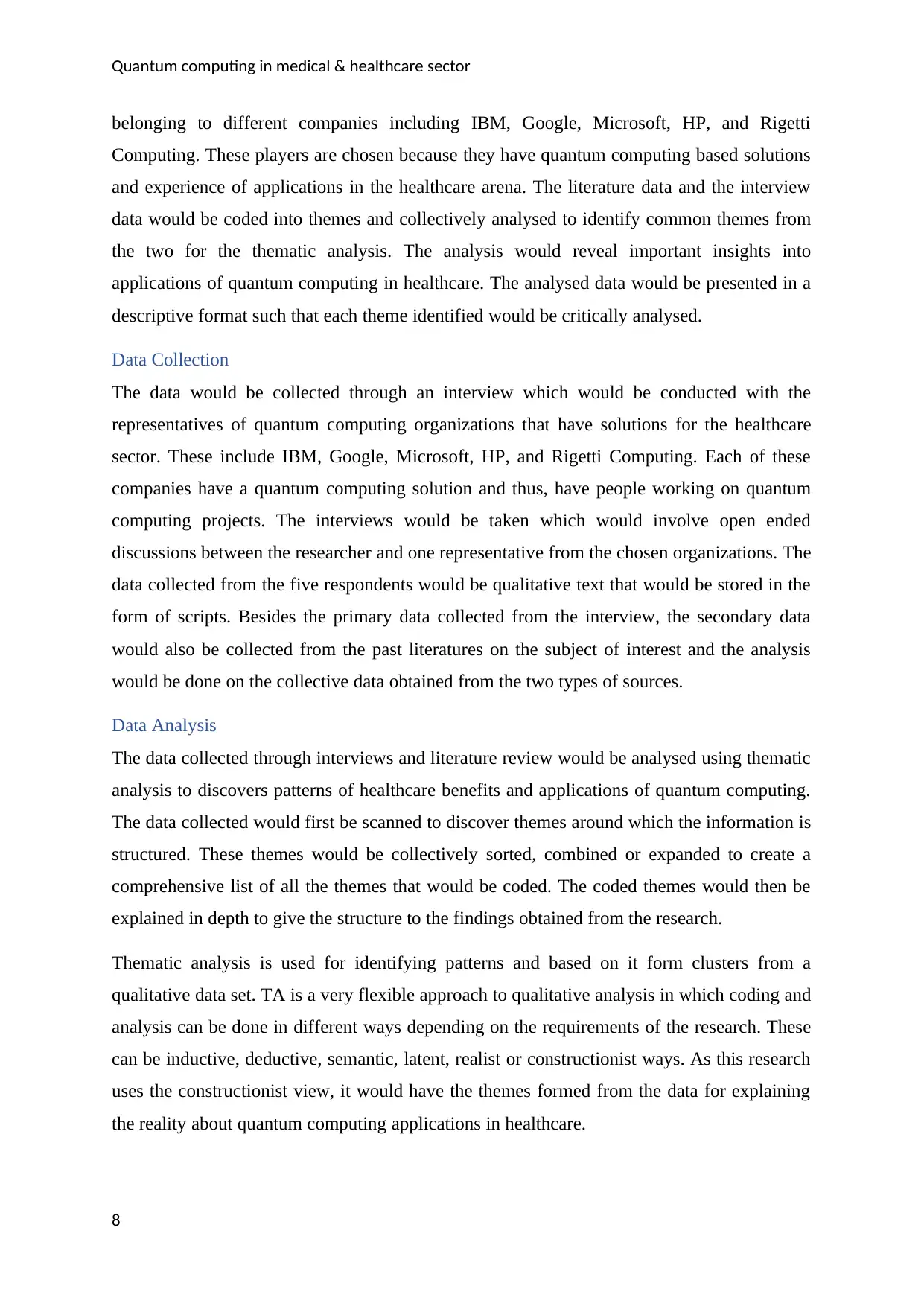
Quantum computing in medical & healthcare sector
belonging to different companies including IBM, Google, Microsoft, HP, and Rigetti
Computing. These players are chosen because they have quantum computing based solutions
and experience of applications in the healthcare arena. The literature data and the interview
data would be coded into themes and collectively analysed to identify common themes from
the two for the thematic analysis. The analysis would reveal important insights into
applications of quantum computing in healthcare. The analysed data would be presented in a
descriptive format such that each theme identified would be critically analysed.
Data Collection
The data would be collected through an interview which would be conducted with the
representatives of quantum computing organizations that have solutions for the healthcare
sector. These include IBM, Google, Microsoft, HP, and Rigetti Computing. Each of these
companies have a quantum computing solution and thus, have people working on quantum
computing projects. The interviews would be taken which would involve open ended
discussions between the researcher and one representative from the chosen organizations. The
data collected from the five respondents would be qualitative text that would be stored in the
form of scripts. Besides the primary data collected from the interview, the secondary data
would also be collected from the past literatures on the subject of interest and the analysis
would be done on the collective data obtained from the two types of sources.
Data Analysis
The data collected through interviews and literature review would be analysed using thematic
analysis to discovers patterns of healthcare benefits and applications of quantum computing.
The data collected would first be scanned to discover themes around which the information is
structured. These themes would be collectively sorted, combined or expanded to create a
comprehensive list of all the themes that would be coded. The coded themes would then be
explained in depth to give the structure to the findings obtained from the research.
Thematic analysis is used for identifying patterns and based on it form clusters from a
qualitative data set. TA is a very flexible approach to qualitative analysis in which coding and
analysis can be done in different ways depending on the requirements of the research. These
can be inductive, deductive, semantic, latent, realist or constructionist ways. As this research
uses the constructionist view, it would have the themes formed from the data for explaining
the reality about quantum computing applications in healthcare.
8
belonging to different companies including IBM, Google, Microsoft, HP, and Rigetti
Computing. These players are chosen because they have quantum computing based solutions
and experience of applications in the healthcare arena. The literature data and the interview
data would be coded into themes and collectively analysed to identify common themes from
the two for the thematic analysis. The analysis would reveal important insights into
applications of quantum computing in healthcare. The analysed data would be presented in a
descriptive format such that each theme identified would be critically analysed.
Data Collection
The data would be collected through an interview which would be conducted with the
representatives of quantum computing organizations that have solutions for the healthcare
sector. These include IBM, Google, Microsoft, HP, and Rigetti Computing. Each of these
companies have a quantum computing solution and thus, have people working on quantum
computing projects. The interviews would be taken which would involve open ended
discussions between the researcher and one representative from the chosen organizations. The
data collected from the five respondents would be qualitative text that would be stored in the
form of scripts. Besides the primary data collected from the interview, the secondary data
would also be collected from the past literatures on the subject of interest and the analysis
would be done on the collective data obtained from the two types of sources.
Data Analysis
The data collected through interviews and literature review would be analysed using thematic
analysis to discovers patterns of healthcare benefits and applications of quantum computing.
The data collected would first be scanned to discover themes around which the information is
structured. These themes would be collectively sorted, combined or expanded to create a
comprehensive list of all the themes that would be coded. The coded themes would then be
explained in depth to give the structure to the findings obtained from the research.
Thematic analysis is used for identifying patterns and based on it form clusters from a
qualitative data set. TA is a very flexible approach to qualitative analysis in which coding and
analysis can be done in different ways depending on the requirements of the research. These
can be inductive, deductive, semantic, latent, realist or constructionist ways. As this research
uses the constructionist view, it would have the themes formed from the data for explaining
the reality about quantum computing applications in healthcare.
8
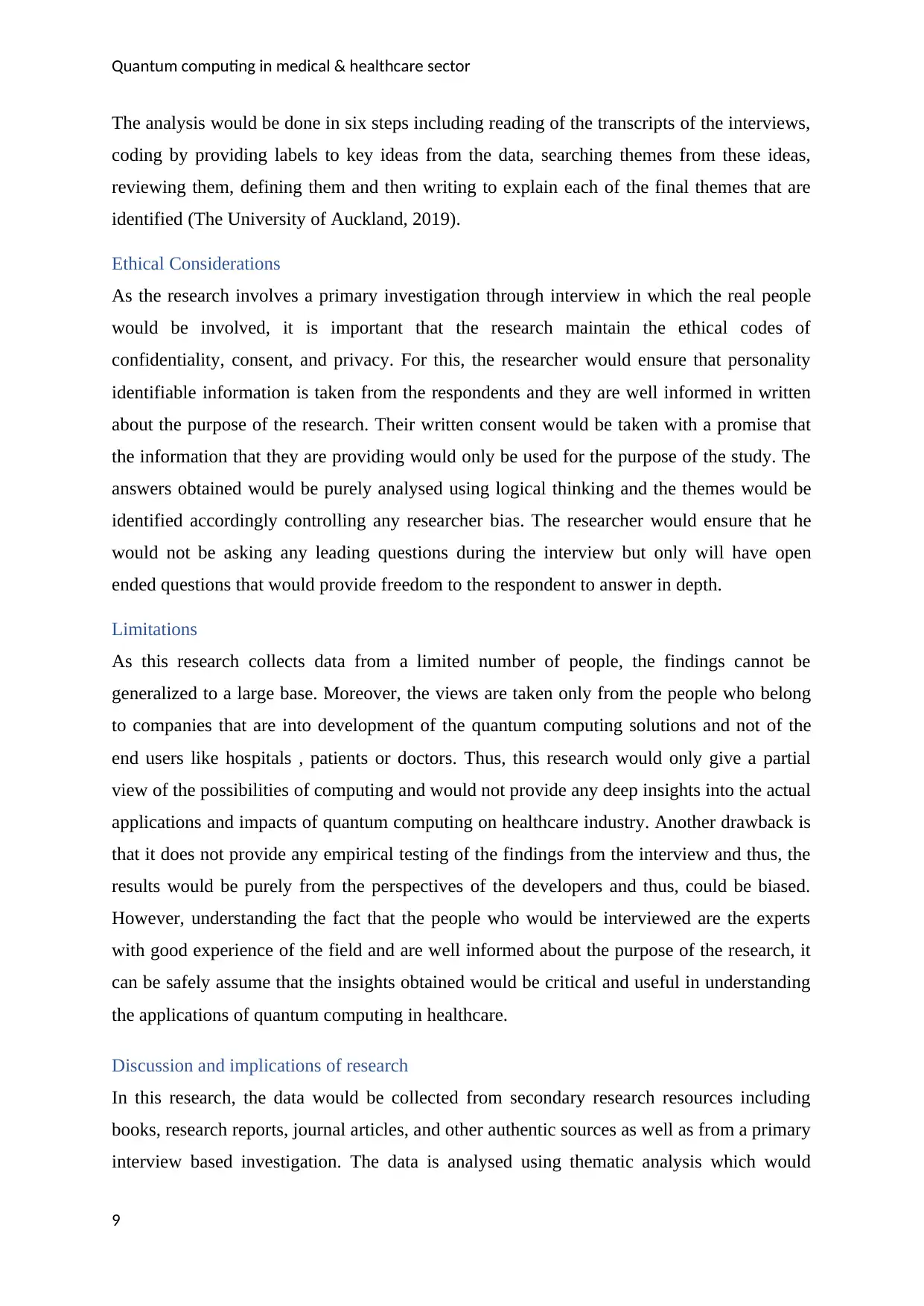
Quantum computing in medical & healthcare sector
The analysis would be done in six steps including reading of the transcripts of the interviews,
coding by providing labels to key ideas from the data, searching themes from these ideas,
reviewing them, defining them and then writing to explain each of the final themes that are
identified (The University of Auckland, 2019).
Ethical Considerations
As the research involves a primary investigation through interview in which the real people
would be involved, it is important that the research maintain the ethical codes of
confidentiality, consent, and privacy. For this, the researcher would ensure that personality
identifiable information is taken from the respondents and they are well informed in written
about the purpose of the research. Their written consent would be taken with a promise that
the information that they are providing would only be used for the purpose of the study. The
answers obtained would be purely analysed using logical thinking and the themes would be
identified accordingly controlling any researcher bias. The researcher would ensure that he
would not be asking any leading questions during the interview but only will have open
ended questions that would provide freedom to the respondent to answer in depth.
Limitations
As this research collects data from a limited number of people, the findings cannot be
generalized to a large base. Moreover, the views are taken only from the people who belong
to companies that are into development of the quantum computing solutions and not of the
end users like hospitals , patients or doctors. Thus, this research would only give a partial
view of the possibilities of computing and would not provide any deep insights into the actual
applications and impacts of quantum computing on healthcare industry. Another drawback is
that it does not provide any empirical testing of the findings from the interview and thus, the
results would be purely from the perspectives of the developers and thus, could be biased.
However, understanding the fact that the people who would be interviewed are the experts
with good experience of the field and are well informed about the purpose of the research, it
can be safely assume that the insights obtained would be critical and useful in understanding
the applications of quantum computing in healthcare.
Discussion and implications of research
In this research, the data would be collected from secondary research resources including
books, research reports, journal articles, and other authentic sources as well as from a primary
interview based investigation. The data is analysed using thematic analysis which would
9
The analysis would be done in six steps including reading of the transcripts of the interviews,
coding by providing labels to key ideas from the data, searching themes from these ideas,
reviewing them, defining them and then writing to explain each of the final themes that are
identified (The University of Auckland, 2019).
Ethical Considerations
As the research involves a primary investigation through interview in which the real people
would be involved, it is important that the research maintain the ethical codes of
confidentiality, consent, and privacy. For this, the researcher would ensure that personality
identifiable information is taken from the respondents and they are well informed in written
about the purpose of the research. Their written consent would be taken with a promise that
the information that they are providing would only be used for the purpose of the study. The
answers obtained would be purely analysed using logical thinking and the themes would be
identified accordingly controlling any researcher bias. The researcher would ensure that he
would not be asking any leading questions during the interview but only will have open
ended questions that would provide freedom to the respondent to answer in depth.
Limitations
As this research collects data from a limited number of people, the findings cannot be
generalized to a large base. Moreover, the views are taken only from the people who belong
to companies that are into development of the quantum computing solutions and not of the
end users like hospitals , patients or doctors. Thus, this research would only give a partial
view of the possibilities of computing and would not provide any deep insights into the actual
applications and impacts of quantum computing on healthcare industry. Another drawback is
that it does not provide any empirical testing of the findings from the interview and thus, the
results would be purely from the perspectives of the developers and thus, could be biased.
However, understanding the fact that the people who would be interviewed are the experts
with good experience of the field and are well informed about the purpose of the research, it
can be safely assume that the insights obtained would be critical and useful in understanding
the applications of quantum computing in healthcare.
Discussion and implications of research
In this research, the data would be collected from secondary research resources including
books, research reports, journal articles, and other authentic sources as well as from a primary
interview based investigation. The data is analysed using thematic analysis which would
9
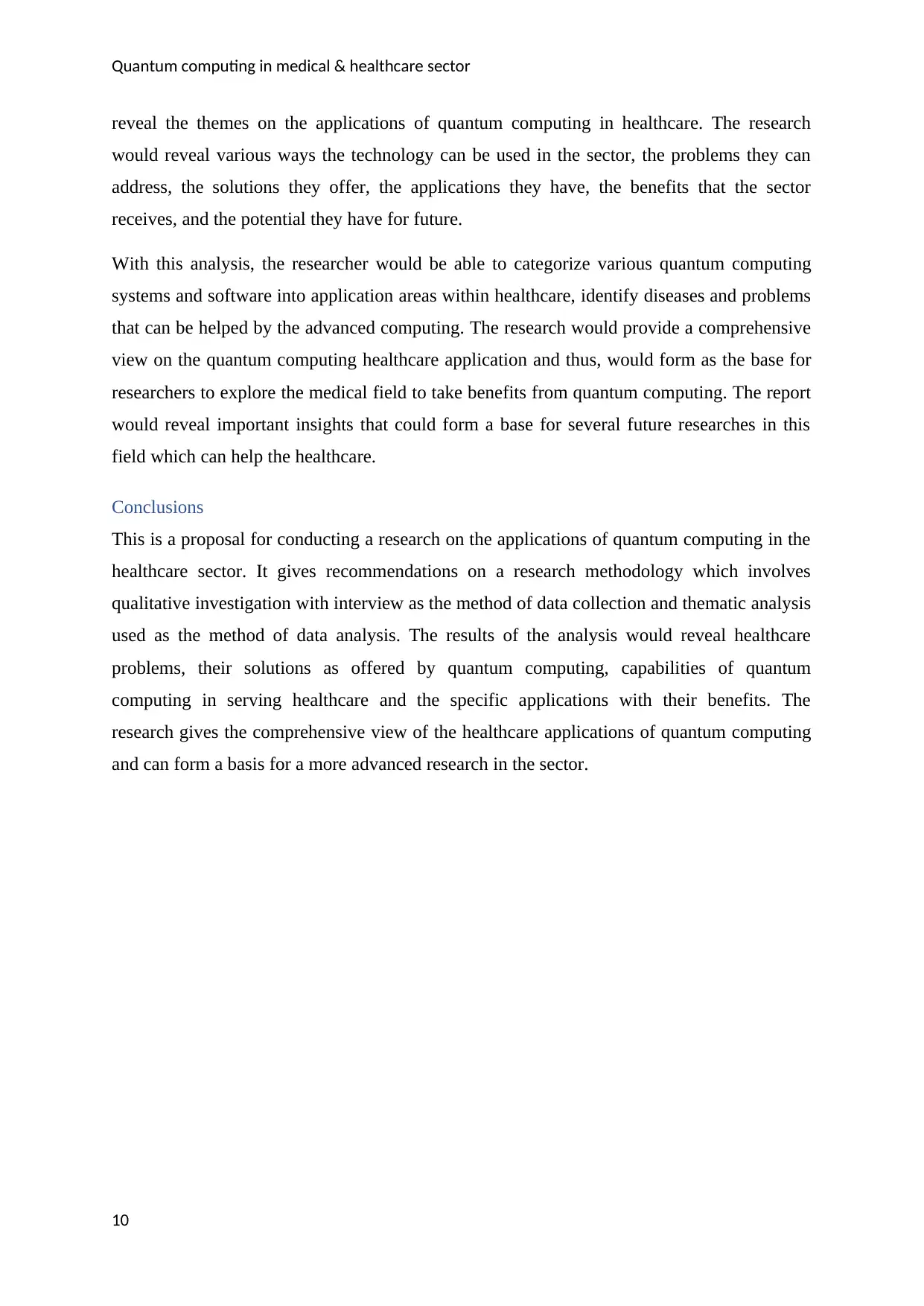
Quantum computing in medical & healthcare sector
reveal the themes on the applications of quantum computing in healthcare. The research
would reveal various ways the technology can be used in the sector, the problems they can
address, the solutions they offer, the applications they have, the benefits that the sector
receives, and the potential they have for future.
With this analysis, the researcher would be able to categorize various quantum computing
systems and software into application areas within healthcare, identify diseases and problems
that can be helped by the advanced computing. The research would provide a comprehensive
view on the quantum computing healthcare application and thus, would form as the base for
researchers to explore the medical field to take benefits from quantum computing. The report
would reveal important insights that could form a base for several future researches in this
field which can help the healthcare.
Conclusions
This is a proposal for conducting a research on the applications of quantum computing in the
healthcare sector. It gives recommendations on a research methodology which involves
qualitative investigation with interview as the method of data collection and thematic analysis
used as the method of data analysis. The results of the analysis would reveal healthcare
problems, their solutions as offered by quantum computing, capabilities of quantum
computing in serving healthcare and the specific applications with their benefits. The
research gives the comprehensive view of the healthcare applications of quantum computing
and can form a basis for a more advanced research in the sector.
10
reveal the themes on the applications of quantum computing in healthcare. The research
would reveal various ways the technology can be used in the sector, the problems they can
address, the solutions they offer, the applications they have, the benefits that the sector
receives, and the potential they have for future.
With this analysis, the researcher would be able to categorize various quantum computing
systems and software into application areas within healthcare, identify diseases and problems
that can be helped by the advanced computing. The research would provide a comprehensive
view on the quantum computing healthcare application and thus, would form as the base for
researchers to explore the medical field to take benefits from quantum computing. The report
would reveal important insights that could form a base for several future researches in this
field which can help the healthcare.
Conclusions
This is a proposal for conducting a research on the applications of quantum computing in the
healthcare sector. It gives recommendations on a research methodology which involves
qualitative investigation with interview as the method of data collection and thematic analysis
used as the method of data analysis. The results of the analysis would reveal healthcare
problems, their solutions as offered by quantum computing, capabilities of quantum
computing in serving healthcare and the specific applications with their benefits. The
research gives the comprehensive view of the healthcare applications of quantum computing
and can form a basis for a more advanced research in the sector.
10
Secure Best Marks with AI Grader
Need help grading? Try our AI Grader for instant feedback on your assignments.
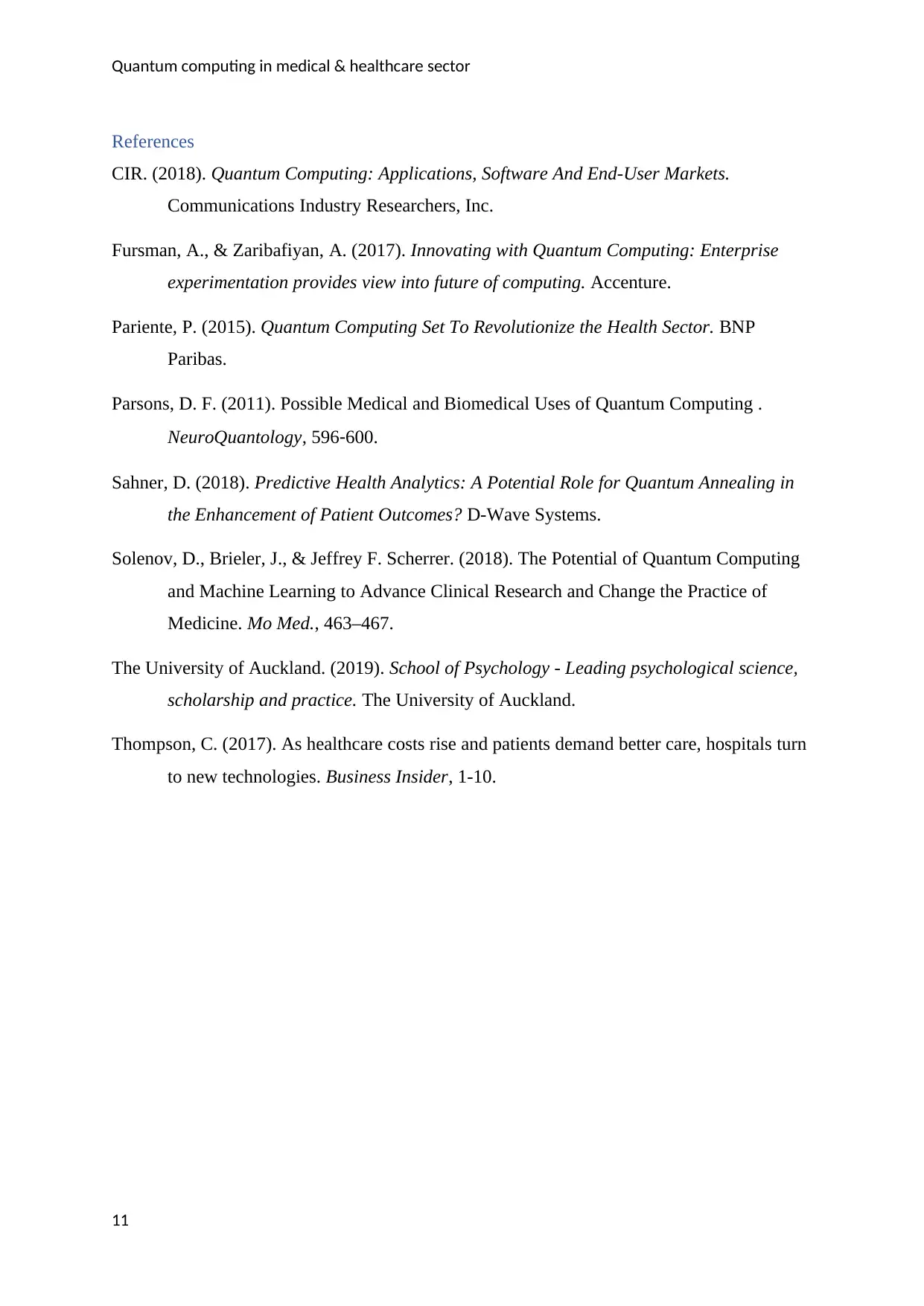
Quantum computing in medical & healthcare sector
References
CIR. (2018). Quantum Computing: Applications, Software And End-User Markets.
Communications Industry Researchers, Inc.
Fursman, A., & Zaribafiyan, A. (2017). Innovating with Quantum Computing: Enterprise
experimentation provides view into future of computing. Accenture.
Pariente, P. (2015). Quantum Computing Set To Revolutionize the Health Sector. BNP
Paribas.
Parsons, D. F. (2011). Possible Medical and Biomedical Uses of Quantum Computing .
NeuroQuantology, 596‐600.
Sahner, D. (2018). Predictive Health Analytics: A Potential Role for Quantum Annealing in
the Enhancement of Patient Outcomes? D-Wave Systems.
Solenov, D., Brieler, J., & Jeffrey F. Scherrer. (2018). The Potential of Quantum Computing
and Machine Learning to Advance Clinical Research and Change the Practice of
Medicine. Mo Med., 463–467.
The University of Auckland. (2019). School of Psychology - Leading psychological science,
scholarship and practice. The University of Auckland.
Thompson, C. (2017). As healthcare costs rise and patients demand better care, hospitals turn
to new technologies. Business Insider, 1-10.
11
References
CIR. (2018). Quantum Computing: Applications, Software And End-User Markets.
Communications Industry Researchers, Inc.
Fursman, A., & Zaribafiyan, A. (2017). Innovating with Quantum Computing: Enterprise
experimentation provides view into future of computing. Accenture.
Pariente, P. (2015). Quantum Computing Set To Revolutionize the Health Sector. BNP
Paribas.
Parsons, D. F. (2011). Possible Medical and Biomedical Uses of Quantum Computing .
NeuroQuantology, 596‐600.
Sahner, D. (2018). Predictive Health Analytics: A Potential Role for Quantum Annealing in
the Enhancement of Patient Outcomes? D-Wave Systems.
Solenov, D., Brieler, J., & Jeffrey F. Scherrer. (2018). The Potential of Quantum Computing
and Machine Learning to Advance Clinical Research and Change the Practice of
Medicine. Mo Med., 463–467.
The University of Auckland. (2019). School of Psychology - Leading psychological science,
scholarship and practice. The University of Auckland.
Thompson, C. (2017). As healthcare costs rise and patients demand better care, hospitals turn
to new technologies. Business Insider, 1-10.
11
1 out of 11
Your All-in-One AI-Powered Toolkit for Academic Success.
+13062052269
info@desklib.com
Available 24*7 on WhatsApp / Email
![[object Object]](/_next/static/media/star-bottom.7253800d.svg)
Unlock your academic potential
© 2024 | Zucol Services PVT LTD | All rights reserved.




